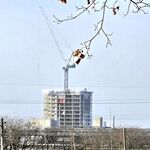Johnny Au
Senior Member
Oakwood station on November 24, 2021:







This is the first time in North America that a public transit system of this size will be equipped with platform screen doors. Also called platform edge doors, these glass doors located along the station platforms, separating the platform from the tracks, open automatically and only when the metro is stopped at the station.
Platform screen door technology is used in large networks around the world, particularly in Paris, London and Tokyo where its many advantages have been demonstrated. For the REM, the use of platform screen doors offers many advantages: increased service reliability and safety, easier flow of passengers entering and exiting the metro cars, and minimized heat loss between the cars and the station.
The platform screen doors for the REM stations are installed using a modular platform specially designed for the project; an innovative and, above all, highly efficient installation technique. The modular platform, which moves on the rails, allows the platform screen door modules to be installed from outside the station platform, using two robotic arms. The result is an extremely precise installation, carried out in complete safety for workers following a door module pre-assembly process carried out in a factory in Montréal, Québec.
The use of platform screen doors will prevent objects from falling onto the tracks, which is a frequent cause of service slowdowns or interruptions. In the case of the Montréal metro, nearly 50% of service interruptions are caused by customer-related behaviour (people who are ill, doors held back, objects on the track, etc.).
Platform screen doors also prevent the piston effect caused by the rapid movement of trains (the airstream felt by passengers waiting on the platform and that can knock them off balance). This technology therefore prevents accidents and falls onto the tracks, but also unauthorized access, making travel safer.

It's the subway section that's the issue. Look at how quick the surface section was in Scarborough!
They wern't part of the plan. Personally, I think the benefit of them is highly debatable and it seems to be something that some places embrace more than others for example in London only one section of a line has them and then even just opened a new section of aline and didn't use them on it. I think what we need to do is instead of just shifting the problem of people committing suicide by building barriers to it instead we should address it by trying to help more people who are mentally not well and need help.How's the installation of platform screen doors on Line 5 going? Strangely quiet compared with REM in Montréal.
Installation of platform screen doors for dynamic tests on the representative segment
From link. Dated December 8, 2020.

Meanwhile, in Toronto, where non-transit using powers-that-be make the decisions...
From link.
Of course preventing suicides is preferable to building barriers to it. But, let's be honest, you can't prevent suicides 100%, and if somebody really wanted to do something like that, it would be preferable if they did it in such a way that it does not disrupt tens of thousands of other people who are using public transit, and in a way that does not potentially leave subway train operators with PTSD.They wern't part of the plan. Personally, I think the benefit of them is highly debatable and it seems to be something that some places embrace more than others for example in London only one section of a line has them and then even just opened a new section of aline and didn't use them on it. I think what we need to do is instead of just shifting the problem of people committing suicide by building barriers to it instead we should address it by trying to help more people who are mentally not well and need help.
I get the argument I'm just pointing out that a lot of places have built new lines or added to existing ones and they weren't used for various reasons.Of course preventing suicides is preferable to building barriers to it. But, let's be honest, you can't prevent suicides 100%, and if somebody really wanted to do something like that, it would be preferable if they did it in such a way that it does not disrupt tens of thousands of other people who are using public transit, and in a way that does not potentially leave subway train operators with PTSD.
And platforms screen doors have lots of other benefits - you also prevent objects falling on tracks (like phones or wallets or other things) which may disrupt service, you increase boarding speeds since people can queue at the correct location every time, and you make better use of platform space since people are now able to stand all the way up to the edge of the platform. If they are full height platform screen doors, they also allow air conditioning or heating on the platform, which is especially useful on above-ground stations. Also, platform screen doors allow the train to arrive and leave the station at higher speed, since there is no safety concern of the train moving at high speed next to a crowded platform, and this could probably save a couple minutes on a long journey.
Platform screen doors are often expensive to retrofit due to ventilation, antiquated signalling, and other issues, and even on extensions they can be unfeasible if the line doesn't use ATC, but on new lines they're a no-brainer IMO. And on old lines that have modern signalling, half-height ones are probably a good idea.
The likely reaction by the non-transit using politicians...They wern't part of the plan. Personally, I think the benefit of them is highly debatable and it seems to be something that some places embrace more than others for example in London only one section of a line has them and then even just opened a new section of aline and didn't use them on it. I think what we need to do is instead of just shifting the problem of people committing suicide by building barriers to it instead we should address it by trying to help more people who are mentally not well and need help.
Why? I personally don't see the downside other than cost, and that is minimal when you're building a new line.I get the argument I'm just pointing out that a lot of places have built new lines or added to existing ones and they weren't used for various reasons.
Agreed.I think a lot of people think that they are useful and that they should be added to every new project but it doesn't really make sense to me to add it to only a few places and not others like for example when the extrusion of line 2 is built I don't expect them to add them unless they actually plan to put them on the rest of the line.
It makes it much easier to install HVAC systems.Also I think that a lot of people have ideas of fantasy about them like thinking that having them will mean that the station is going to have HVAC systems installed in them.
I get the argument I'm just pointing out that a lot of places have built new lines or added to existing ones and they weren't used for various reasons.
I think a lot of people think that they are useful and that they should be added to every new project but it doesn't really make sense to me to add it to only a few places and not others like for example when the extrusion of line 2 is built I don't expect them to add them unless they actually plan to put them on the rest of the line.
Also I think that a lot of people have ideas of fantasy about them like thinking that having them will mean that the station is going to have HVAC systems installed in them.
Huh? How is their a reduction in cost to a sation by putting in platform edge doors? The crosstown wasn't designed for them because of the vechles selected for it would have no benefit from them.One major benefit is reduced station construction cost. If you assume platform doors will be in place, then you can also have platform edge pillars to support the roof, reducing the length of the horizontal spans.
IIRC, Crosstown stations were designed before TTC had a firm plan for ATO, shortly after platform edge pillars were removed from the Spadina extension.
Which no subway systems actually have except for the staff. Adding it is a waste of money.makes it much easier to install HVAC systems.
Nope it wasn't designed to have them because they make no sense on a low floor light rail line.The likely reaction by the non-transit using politicians...
Well, it can help with crowded platforms. Trains don't charge in cause they fear someone could have slip when they are pack to the platform edge. Track fire is not an issue with overhead rails.Nope it wasn't designed to have them because they make no sense on a low floor light rail line.




